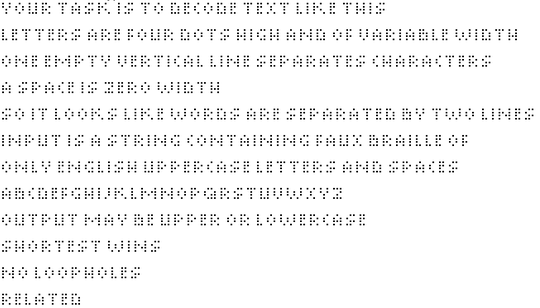21
3
⢣⠃⢎⠆⣇⡇⡯⡂⠈⡏⢰⢵⢐⡭⢸⠪⡀⢸⢐⡭⠀⢹⠁⢎⠆⢸⣱⢸⡃⢎⠰⡱⢸⣱⢸⡃⠈⡏⢸⡃⡱⡁⢹⠁⢸⡀⡇⡗⢅⢸⡃⠈⡏⢸⢼⢸⢐⡭⠀
⣇⢸⡃⢹⠁⢹⠁⣟⢸⢕⢐⡭⠀⡮⡆⡯⡂⣟⠀⡯⠰⡱⢸⣸⢸⢕⠀⣏⡆⢎⠆⢹⠁⣪⠅⢸⢼⢸⠰⣩⢸⢼⠀⡮⡆⡗⢼⢸⣱⠀⢎⠆⡯⠀⢇⠇⡮⡆⡯⡂⡇⡮⡆⣟⡆⣇⢸⡃⠸⡰⡸⢸⢸⣱⠈⡏⢸⢼⠀
⢎⠆⡗⢼⢸⡃⢸⡃⡗⠔⡇⡯⠂⢹⠁⢣⠃⠸⡸⢸⡃⡯⡂⢹⠁⡇⢎⢰⢵⢸⡀⢸⡀⡇⡗⢼⢸⡃⢐⡭⢸⡃⡯⠂⡮⡆⡯⡂⡮⡆⢹⠁⣟⢐⡭⠀⢎⢸⢼⢰⢵⢸⢕⢰⢵⠰⡁⢹⠁⣟⢸⢕⢐⡭⠀
⡮⡆⢐⡭⢸⠕⢰⢵⠰⡁⣟⠀⡇⣪⠅⢈⣝⢸⡃⡯⡂⢎⠆⠸⡰⡸⢸⢸⣱⠈⡏⢸⢼⠀
⣪⠅⢎⠆⢸⠈⡏⠀⣇⠰⡱⠰⡱⢸⠪⡀⣪⠅⢸⡀⡇⡗⢅⢸⡃⠸⡰⡸⠰⡱⢸⢕⢸⣱⢐⡭⠀⡮⡆⡯⡂⣟⠀⣪⠅⣟⢸⠕⢰⢵⢸⢕⢰⢵⠈⡏⢸⡃⣏⡆⢸⣳⠘⡜⠀⢹⠁⢇⢆⠇⢎⠆⢸⡀⡇⡗⢼⢸⡃⣪⠅
⡇⡗⢼⢸⠕⢸⣸⠈⡏⠀⡇⣪⠅⢰⢵⠀⣪⠅⢹⠁⡯⡂⡇⡗⢼⠰⣩⠀⢎⠰⡱⢸⠢⡇⢹⠁⡮⡆⡇⡗⢼⢸⢸⠢⡇⢎⡅⢸⠅⡮⡆⣇⡇⡱⡁⢸⣳⢸⢕⢰⢵⢸⢸⡀⣇⢸⡃⠰⡱⢸⠅
⢎⠆⡗⢼⢸⡀⢣⠃⢸⡃⡗⢼⠰⣩⢸⡀⡇⣪⠅⡧⡇⢸⣸⢸⠕⢸⠕⢸⡃⡯⡂⢎⢰⢵⢐⡭⢸⡃⢸⡀⣟⠈⡏⠈⡏⢸⡃⡯⡂⣪⠅⢰⢵⢸⠢⡇⣏⡆⢐⡭⢸⠕⢰⢵⠰⡁⣟⢐⡭⠀
⡮⡆⣟⡆⢎⢸⣱⢸⡃⡯⠰⣩⢸⢼⢸⢀⠇⡗⢅⢸⡀⡗⠔⡇⡗⢼⠰⡱⢸⠕⠰⣩⡆⡯⡂⣪⠅⢹⠁⣇⡇⢇⠇⢇⢆⠇⡱⡁⢣⠃⣩⡃
⢎⠆⣇⡇⢹⠁⡯⠂⣇⡇⢹⠁⢸⠢⢺⢰⢵⠘⡜⠀⣟⡆⣟⠀⣇⡇⡯⠂⡯⠂⣟⢸⢕⠀⢎⠆⡯⡂⢸⡀⢎⠆⢇⢆⠇⣟⢸⢕⠰⡁⡮⡆⣪⠅⣟⠀
⣪⠅⡧⡇⢎⠆⡯⡂⢹⠁⣟⢐⡭⠈⡏⠀⢇⢆⠇⡇⡗⢼⢐⡭⠀
⡗⢼⠰⡱⠀⣇⠰⡱⠰⡱⢸⠕⢸⢼⠰⡱⢸⡀⣟⢐⡭⠀
About Braille characters
A Braille character packs a 4 by 2 rectangle of dots, which can be viewed as a Boolean matrix.
The concatenation of all such matrices is a 4 by 2*n boolean matrix, where n is the length of the input string.
You should look for vertical lines without any dots in them, and use those as separators to split the big matrix into smaller matrices for each character.
Then, look for patterns to convert them to letters of the English alphabet or spaces. Note that after removing the separators (vertical empty lines), a space is a 4 by 0 matrix.
Below is a description of the alphabet in ASCII:
A | B | C | D | E | F | G | H | I | J | K | L | M | N | O | P | Q | R | S | T | U | V | W | X | Y | Z
----+-----+----+-----+----+----+-----+-----+---+----+------+----+-------+------+-----+-----+------+-----+-----+-----+-----+-----+-------+-----+-----+----
.#. | ##. | .# | ##. | ## | ## | .## | #.# | # | .# | #.#. | #. | #...# | #..# | .#. | ##. | .##. | ##. | .## | ### | #.# | #.# | #...# | #.# | #.# | ###
#.# | ### | #. | #.# | ## | #. | #.. | #.# | # | .# | ##.. | #. | ##.## | ##.# | #.# | #.# | #..# | #.# | #.. | .#. | #.# | #.# | #.#.# | .#. | #.# | ..#
### | #.# | #. | #.# | #. | ## | #.# | ### | # | .# | #.#. | #. | #.#.# | #.## | #.# | ##. | #.## | ##. | .## | .#. | #.# | #.# | #.#.# | .#. | .#. | .#.
#.# | ### | .# | ### | ## | #. | .## | #.# | # | #. | #..# | ## | #...# | #..# | .#. | #.. | .### | #.# | ##. | .#. | ### | .#. | .#.#. | #.# | .#. | ###
Specification
The input is a sequence of Unicode code points in the range U+2800..U+28FF represented as the usual string type in your language (e.g. char array, char pointer) in any popular encoding supported (UTF-8, UCS-2, etc).
Trailing spaces in the output are fine.
EDIT: apologies to those whose browsers misrender the dots, it's supposed to look like this (image):

5your task is to decode text like this / letters are four dots high and of variable width / one empty vertical line separates characters / a space is zero width / so it looks like words are separated by two lines / input is a string containing faux braille of / only english uppercase letters and spaces / abcdefghijklmnopqrstuvwxyz / output may be upper or lowercase / shortest wins / no loopholes / related – ngn – 2017-11-26T09:41:20.223
2Braille patterns – Arnauld – 2017-11-26T10:26:05.343